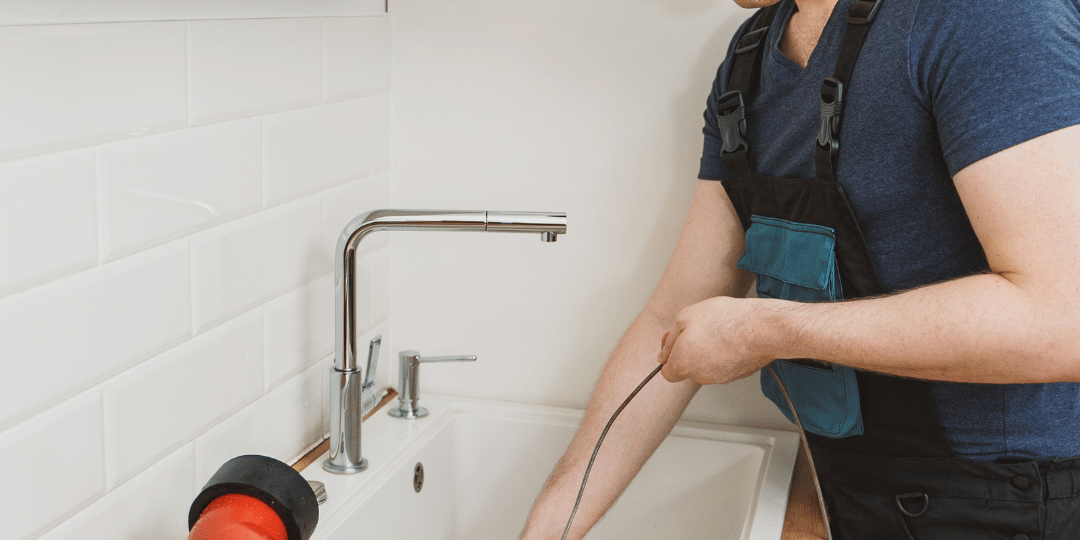A properly functioning kitchen drain is essential for maintaining a clean, efficient, and hygienic kitchen environment. Whether you’re dealing with a slow drain, leaks, or planning a new installation, understanding the basics of kitchen drain plumbing can save you time, money, and frustration. At The Family Plumber, we specialize in residential and commercial plumbing repairs in the greater Surprise, Arizona area, offering expert solutions that keep your kitchen—and your entire home—running smoothly.
In this article, we’ll cover everything from the types of pipes used in kitchen drains to how to connect your kitchen waste properly. We’ll also explore important plumbing codes, installation tips, and common questions like “What type of pipe for kitchen drain?” and “How do you install a kitchen drain in the sink?” Whether you’re a DIY enthusiast or considering professional help, this guide is designed to provide the information you need.
What Type of Pipe is Used for Kitchen Drains?
Choosing the right type of pipe for your kitchen drain is crucial for ensuring durability, proper drainage, and compliance with plumbing codes. Several types of pipes are commonly used in kitchen drain plumbing, each with its own advantages:
- PVC (Polyvinyl Chloride):
PVC is the most popular choice for kitchen drain pipes due to its affordability, ease of installation, and resistance to corrosion. It’s lightweight and works well for both residential and commercial kitchens. PVC pipes are also compatible with most plumbing fittings and are approved under most local plumbing codes. - ABS (Acrylonitrile Butadiene Styrene):
ABS pipes are similar to PVC but are typically black in color. They are known for their toughness and are often used in colder climates due to their ability to withstand temperature changes. ABS is also easy to install and resistant to impact damage. - Cast Iron:
Although heavier and more expensive, cast iron pipes are still used in some commercial kitchens because of their durability and noise-reducing properties. They offer excellent longevity but require professional installation and maintenance. - Copper:
Copper pipes are generally used for water supply lines rather than drains, but in some cases, they may be found in kitchen plumbing. They are durable and corrosion-resistant but can be costlier than PVC or ABS.
At The Family Plumber, we recommend PVC or ABS for most kitchen drain applications in the greater Surprise, Arizona area, thanks to their reliability and compliance with local plumbing codes. Using the right pipe ensures smooth flow through your drains, reduces the risk of leaks, and helps avoid costly plumbing repairs down the road.
Understanding the Kitchen Drainage System
The kitchen drainage system is a critical part of your home’s plumbing network that ensures wastewater from your sink, dishwasher, and garbage disposal is safely carried away. Understanding how this system works helps you maintain proper function and avoid costly repairs.
Key Components of the Kitchen Drainage System:
- Drain Pipes: These carry wastewater away from your kitchen sink and appliances to the main sewer line. They are typically made from PVC or ABS materials.
- P-Trap: Located directly beneath your kitchen sink, the P-trap holds a small amount of water to create a seal that prevents sewer gases from entering your home. It also traps debris, preventing clogs further down the line.
- Vent Pipes: Ventilation pipes allow air to enter the plumbing system, which helps maintain proper drainage pressure and prevents water from being siphoned out of the P-trap.
- Connection to Sewers: The kitchen drain system connects to your home’s main sewer or septic system, where wastewater is treated or safely dispersed.
A properly designed drainage system ensures your kitchen waste flows smoothly, prevents odors, and avoids backflow issues. It’s essential that drains are connected correctly and comply with local plumbing codes, which include specifications for pipe sizes, venting, and trap installation.
At The Family Plumber, we provide expert drain inspections and repairs, ensuring your kitchen and entire home plumbing system is working efficiently and safely.
Plumbing Code for Kitchen Sink Drains
When it comes to kitchen drain plumbing, adhering to local plumbing codes is essential for safety, functionality, and avoiding costly violations. Plumbing codes dictate how kitchen sinks and drains should be installed, ensuring the system operates efficiently and protects your home.
Key Plumbing Code Requirements for Kitchen Sink Drains:
- Pipe Size:
Most plumbing codes require that kitchen sink drains use at least a 1.5-inch diameter pipe to ensure proper water flow and prevent clogs. - Trap Installation:
A P-trap must be installed directly beneath the sink to prevent sewer gases from entering your home. The trap should be easily accessible for cleaning and maintenance. - Venting:
Proper venting is mandatory to allow air into the drainage system, preventing suction that can empty the trap and allow odors to escape. Vents must meet local specifications regarding size and placement. - Slope:
Drain pipes should be installed with a minimum slope (usually 1/4 inch per foot) to ensure wastewater flows smoothly toward the sewer or septic system. - Connection to Garbage Disposal:
If you have a garbage disposal, it must be properly connected to the drain with appropriate fittings and a dishwasher drain connection if applicable. - Material Compliance:
Pipes and fittings must meet approved standards such as PVC, ABS, or cast iron per local codes.
For residents and businesses in Surprise, Arizona, The Family Plumber ensures all kitchen drain installations and repairs fully comply with the local plumbing code, avoiding problems and ensuring safe, long-lasting performance.
How to Connect Kitchen Waste to the Drain
Connecting your kitchen waste pipes properly is essential to maintaining a leak-free, efficient drainage system. Whether you’re installing a new kitchen sink, replacing a garbage disposal, or updating plumbing, understanding how to connect kitchen waste to the drain will help avoid costly issues later on.
Steps to Connect Kitchen Waste to the Drain:
- Install the Drain Assembly:
Begin by attaching the drain flange and basket strainer to the sink. Apply plumber’s putty around the drain opening to ensure a watertight seal. - Attach the P-Trap:
Connect the P-trap to the drain tailpiece under the sink. The P-trap’s curved shape prevents sewer gases from entering your home while catching debris that could clog the pipes. - Connect to the Main Drain Line:
The other end of the P-trap connects to the home’s main drain pipe, usually a 1.5 or 2-inch PVC pipe. Use slip joint nuts and washers to secure the connections tightly, ensuring no leaks. - Connect the Garbage Disposal (if applicable):
If your kitchen includes a garbage disposal, connect it to the sink drain using the appropriate fittings. Make sure to connect the dishwasher drain line to the disposal’s inlet port if you have one. - Seal All Joints and Check for Leaks:
Once all connections are in place, tighten all fittings and check for leaks by running water through the sink. If any leaks are found, tighten connections or replace faulty washers.
Properly connecting kitchen waste pipes ensures your drains work efficiently and prevents leaks that could lead to water damage or mold. At The Family Plumber, we specialize in expert plumbing repairs and drain connections to keep your kitchen flowing smoothly.
How Should Our Drains Be Connected?
Properly connecting your kitchen drains is key to maintaining a functional and odor-free plumbing system. Incorrect connections can lead to leaks, slow drainage, or sewer gases entering your home. Here’s what you need to know to ensure your drains are connected correctly:
Best Practices for Connecting Kitchen Drains:
- Use Proper Pipe Materials:
Use approved materials like PVC or ABS pipes for drain connections to ensure durability and compliance with plumbing codes. - Install P-Traps Under Every Sink:
Each kitchen sink or fixture must have a P-trap installed to prevent sewer gases from entering your living space. This is a code requirement and essential for safety. - Ensure Correct Pipe Slope:
Drain pipes should slope downward at about 1/4 inch per foot to allow wastewater to flow freely toward the sewer without pooling or backups. - Keep Drains Ventilated:
Proper venting prevents negative pressure that can siphon water out of traps, leading to foul odors. Vents must be installed per local plumbing codes. - Separate Waste Lines Appropriately:
Avoid combining kitchen drain waste with other waste lines like toilets or showers without proper venting and connection to prevent clogs and backups. - Secure All Connections:
Use slip-joint nuts, washers, and plumber’s tape where needed to secure pipe connections and prevent leaks. - Garbage Disposal Integration:
If you have a garbage disposal, connect it properly to the kitchen drain system with a dishwasher drain line if necessary, ensuring it doesn’t interfere with other drains.
At The Family Plumber, we provide professional drain connection services to ensure your kitchen and home plumbing meet all safety standards and operate efficiently. We also offer leak detection, plumbing repairs, and full sewer services to keep your system in top shape.
How Do You Install a Kitchen Drain in the Sink?
Installing a kitchen drain correctly is essential to ensure proper drainage and prevent leaks or unpleasant odors. Whether you’re replacing an old drain or installing a new sink, following these steps can help you get the job done right.
Step-by-Step Guide to Installing a Kitchen Sink Drain:
- Gather Your Tools and Materials:
You’ll need plumber’s putty, a drain assembly kit, pipe wrench, PVC or ABS pipes, slip-joint nuts, washers, and a P-trap. - Prepare the Sink Drain Hole:
Clean the drain opening on the sink to ensure a good seal with the drain flange. - Apply Plumber’s Putty:
Roll plumber’s putty into a rope and apply it around the underside of the drain flange to create a watertight seal. - Insert the Drain Flange:
Place the flange into the sink’s drain hole and press firmly. - Secure the Drain Body:
Underneath the sink, screw the drain body onto the flange, tightening it securely. Remove any excess plumber’s putty that squeezes out. - Attach the Tailpiece:
Connect the tailpiece to the drain body. This is the straight pipe leading downward from the drain. - Install the P-Trap:
Connect the P-trap to the tailpiece and then to the drain pipe coming from the wall or floor. Use slip-joint nuts and washers to secure the connections. - Connect the Garbage Disposal (If Applicable):
If you have a garbage disposal, connect it according to manufacturer instructions, ensuring the drain pipes and dishwasher lines are properly attached. - Test for Leaks:
Run water through the sink and check all connections for leaks. Tighten fittings as necessary.
Installing a kitchen drain requires attention to detail and proper sealing to prevent leaks and maintain efficient drainage. If you’re unsure or prefer professional assistance, The Family Plumber offers expert installation and repair services throughout the greater Surprise, Arizona area.
Trust The Family Plumber for Expert Kitchen Drain Plumbing
Proper kitchen drain plumbing is essential for maintaining a healthy, functional kitchen. From choosing the right type of pipe and understanding your drainage system to following local plumbing codes and ensuring correct installation, each step plays a vital role in keeping your drains flowing smoothly.
At The Family Plumber, we offer comprehensive plumbing repairs and installations throughout the greater Surprise, Arizona area. Whether you need help with kitchen drains, garbage disposal installation, leak detection, or other plumbing services like water heater repair & installation, toilet repair & installation, or water treatment & purification, our expert team is here to help.
Ready to Solve Your Kitchen Plumbing Issues?
Don’t let a clogged or faulty kitchen drain disrupt your day. Contact The Family Plumber today for fast, reliable, and professional service. Call us at 623-738-6171 or visit our website to schedule an appointment and experience the difference expert plumbing care makes.







